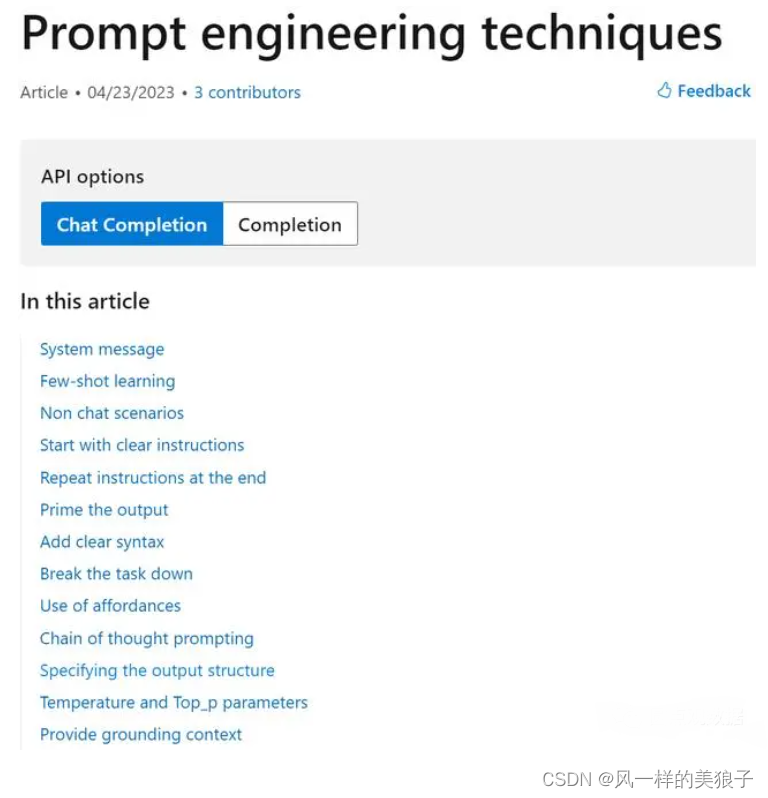Article directory

1 Introduction
Over the past few months, large models such as ChatGPT and GPT-4 have been released one after another. These models exhibit a strong emergent ability, but the results generated by the models are random, good and bad, part of the reason is closely related to the design of Prompt.
2. Large model – Balabala Little Demon Fairy
Many people compare Prompt to the spell of a large model, which has a great influence on guiding the model to generate content. How to choose Prompt has become a concern of every AI researcher.
With large models, the design of Prompt is very important for the model to generate accurate and useful output.
Prompt refers to the text or code fragment used to prompt and guide the language model to generate output in the process of natural language processing. Therefore, the relationship between ChatGPT and Prompt is a cooperative relationship in the process of language model generation output. Prompt provides text or code snippets to guide the model to generate more accurate and useful output.
Specifically, during the training process, Prompt continuously optimizes the parameters of the model to make the generated output more accurate and natural. Along the way, Prompt provides text or code snippets that help the model better understand the problem and generate more accurate and useful output. Therefore, Prompt is one of the important components of ChatGPT, and they cooperate with each other to improve the generation ability of the model.
3. Balabala Little Demon Fairy - Guide the direction
Here are some suggestions for well-designed prompts:
Identify clear directions: When training a model, prompts should give clear directions, for example, indicating what type of output or answers the model should generate.
Provide multiple choices: In order for the model to generate more accurate and useful output, prompts should provide multiple choices, for example, multiple possible answers or questions can be provided to help the model better understand the requirements and generate more natural output .
Formatting output: The format of the prompt should also guide the model, for example, use a descriptive and instructive format to help the model generate more accurate and useful output.
Reasonable length: In some tasks, the length of the prompt may limit the output of the model. Therefore, in order to ensure that the model generates more information, the length of the prompt should be reasonable and long enough.
Experimentation and Evaluation: In order to ensure that the designed prompt is effective, experimentation and evaluation are required. This can include using different prompt designs, adjusting the length and format of prompts, evaluating model responses to different prompts, and more.
In summary, a good prompt design should be able to clearly guide the model, provide multiple choices, format the output, reasonable length and experimental evaluation to help the model generate more accurate and useful output.

3. Two-dimensional beauties or sci-fi pictures-magic
I have summarized some prompts for generating two-dimensional beauties or sci-fi images:
Sailor Moon Prompt: This prompt features a fruit print background with the image of Sailor Moon at the center, which can be used as a drawing, illustration, or digital art.
Cosplay Prompt: This Prompt uses Cosplay elements, and the background is a sci-fi scene, which can be used for Cosplay design, role-playing or digital game design, etc.
Star Wars Prompt: This prompt is themed with a Star Wars background and can be used for Star Wars-themed art design, game design or other related fields.
Robot Prompt: This prompt is robot-themed and can be used for robot-themed illustrations, digital art, and game design.
Monsters and Aliens Prompt: This prompt is themed with monsters and aliens and can be used for monster and alien themed art design, game design and other related fields.
Future City Prompt: This Prompt takes the future city as the theme and can be used in art design, game design and other related fields of the future city theme.
Rocket and Space Prompt: This prompt is rocket and space themed and can be used for rocket and space themed art design, game design and other related fields.
Sci-Fi Spaceship Prompt: This Prompt is themed on a sci-fi spaceship, which can be used for sci-fi spaceship-themed illustrations, digital art, and game design.
Sci-Fi Architecture Prompt: This prompt is themed with sci-fi architecture, which can be used in art design, game design and other related fields of sci-fi architecture theme.
Mysterious Universe Prompt: This Prompt is themed with Mysterious Universe, which can be used in art design, game design and other related fields of Mysterious Universe theme.

4. Cosplay-Magic
Let's take a Cosplay Prompt as an example:
Let's say we have a background image called "Cosplay Prompt" that contains an image of a girl in a superhero costume.
Use this background image as a Cosplay Prompt to create various types of Cosplay works, such as superheroes, anime characters, movie characters, and more.
Adding some decorative elements to this background image, such as adding lightning effects, star decorations, etc., can make the cosplay work more cool.
Using color matching and pattern design can make Cosplay works more visually impactful and artistic.
Adding music and special effects can make Cosplay works more vivid and interesting.
When creating cosplay works, you need to pay attention to the reasonableness and comfort of the clothing to ensure that you will not feel uncomfortable when performing.
Finally, when appreciating your own or others' Cosplay works, you can evaluate them from different angles, such as clothing modeling, performance effects, beauty and creativity.
5. Magician
Recently, Microsoft officially released a tutorial in person, which introduces in detail some advanced gameplay in Prompt design and engineering, covering system messages, few-sample learning, non-chat scenarios, etc.

5.1, system message
System messages are included at the beginning of the Prompt to provide the model with context, instructions, or other information relevant to the use case. Users can describe what the model should and should not answer through system messages, and define the format of the model's reply.
5.2, small sample learning
A common way to adapt a language model to a new task is to use few-shot learning. Few-shot learning provides a set of training samples as part of a prompt to provide additional contextual information to the model.
5.3. Non-dialogue scene
Although the main application scenario of the current large model is the dialog generation scenario, it can also be used in non-dialog scenarios. For example, for a sentiment analysis scenario, you might use the following prompt:

5.4. Use explicit instructions
In general, the order in which information appears in a prompt is important. Since GPT-like models are built in a specific way, the building process defines what the model does with the input. Research has shown that telling the model what you want it to do at the beginning of a prompt, before sharing additional contextual information or examples, can help the model produce higher-quality output.
5.5. Repeat the command at the end
Models are susceptible to recent biases, in which case the end prompt information may have a greater impact on the output than the beginning prompt information. Therefore, repeating instructions at the end of the prompt is worth a try.
5.5. Operation on output
This refers to including a few words or phrases at the end of the prompt to get a model response that conforms to the desired form. For example, using a Prompt such as "Here's a bulleted list of key points:\n- " can help ensure that the output is formatted as a bulleted list.
5.6. Add syntax
Add syntax to prompts, such as punctuation, headings, etc. Doing so makes the output easier to parse.
5.7. Decompose tasks
Large language models (LLMs) often perform better if the task is broken down into smaller steps.
5.8, Thinking Chain Tips
This is a variation of the split task technique. In this approach, instead of splitting the task into smaller steps, the model is instructed to respond step-by-step and present all involved steps. Doing so reduces inaccurate results and makes it easier to evaluate model responses.
5.9. Provide real context
In general, the closer the raw data is to the final answer, the less work the model has to do, which means the less chance the model has to make mistakes.
In addition, Microsoft also introduced other tips about Prompt in this guide. You can go to the original text to get more information.
